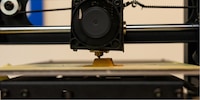
Guide
An overview of the most common 3D printing technologies
by Kevin Hofer

3D printing came into being over 30 years ago. The technology is known as stereolithography. Today, this process, which is undergoing a revival, is giving rise to a veritable revolution. And rightly so, in my view.
Chuck Hull couldn't believe his eyes. It's 9 March 1983 and late. He drags his wife out of bed to show her his invention. He has just developed a stereolithography system.
Subsequently, Chuck Hull founded 3D Systems, a company specialising in stereolithography - more commonly known as SLA - which was also behind the development of the STL file format still used today for 3D models. In stereolithography, the object is obtained by superimposing thin layers of hardened photopolymer resins. You can find out more about this printing process in my review article.
In 1987, Carl Deckard introduced selective laser sintering, a technique in which powder rather than resin is solidified. S. Scott Crump filed a patent in 1989 for Fused Deposition Modeling (FDM) technology, also known as Fused Filament Fabrication (FFF). Also read the article above to find out more!
Today, FFF is the most widely used 3D printing process. The reason? The relatively low price of the printer and printing equipment. You can assemble a printer yourself without too much effort, which also led to the RepRap project. In comparison, SLA printers and resin are extremely expensive.
So why should stereolithography be the future? The technology is the subject of constant research. The main problem with additive manufacturing technology? Layer by layer. You can still make them out, even at a thickness of 0.05 millimetres. The printing doesn't look sharp and takes a relatively long time because of the layering process.
Earlier this year, a research team presented in the journal "Science Advances" a printing technology that the researchers call continuous stereolithography. Unlike conventional stereolithography, models are not created layer by layer. A bas-relief is formed by a light, making the process faster and more precise than conventional stereolithography.
Certainly, FFF currently offers many advantages over stereolithography, particularly in terms of price. However, the advantages of continuous stereolithography outweigh those of SLA and FFF: prints, made in a matter of seconds, are more accurate than with other processes. Price will probably remain the Achilles heel of ALS for a long time to come. In the near future, continuous stereolithography will be used more and more in the professional sector. If we could, at some point in the future, produce prints with a single exposure to light, 3D could then be used in mass production and not just for prototyping. This would completely revolutionise our production. That said, FFF printers are not about to be forgotten, especially when it comes to private applications.
And what do you think? Is stereolithography the future of 3D printing? Will FFF remain the ultimate reference for years to come? Or will there be a new technology - like Computed Axial Lithography (CAL) - that will supplant the current one? Have your say in the comments section!
From big data to big brother, Cyborgs to Sci-Fi. All aspects of technology and society fascinate me.
Interesting facts about products, behind-the-scenes looks at manufacturers and deep-dives on interesting people.
Show all